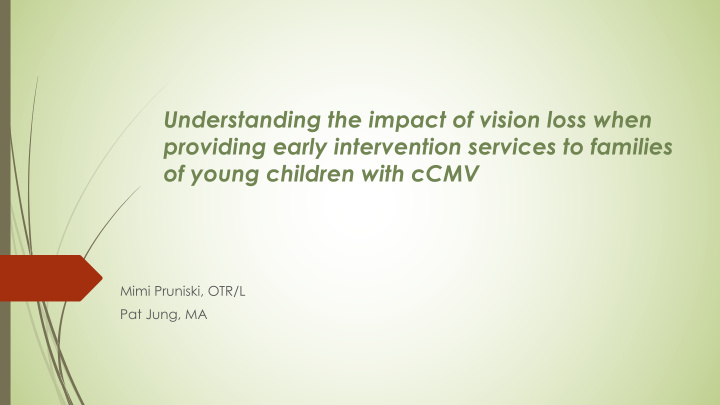



Understanding the impact of vision loss when providing early intervention services to families of young children with cCMV Mimi Pruniski, OTR/L Pat Jung, MA
Objectives ´ Awareness of the most common visual diagnosis associated with cCMV ´ General understanding of CVI and its characteristics ´ What to look for before a referral ´ Activities and Strategies for Adapting the Environment
Vision issues ´ CVI (Cortical Visual Impairment) ´ Cortical blindness ´ Cerebral visual impairment ´ Eye Muscle Issues
Characteristics of CVI - Overview u Light gazing/non-purposeful gaze ´ Color u Distance Viewing ´ Movement u Visual Reflexive Response ´ Latency u Visual Novelty ´ Visual Fields u Visual Motor ´ Complexity
What you may see… ´ A classic characteristic of CVI is that a child might glance at something like a toy, look away, then reach for the object. ´ The environment and physiological factors may affect the child’s visual responses. Such would include noise in the room, visual clutter, fatigue, illness, stress level, new surroundings, amount of light in the room, excitement, etc. ´ Need more processing time; wait time (delayed response when looking) ´ Preference for toys of a specific color, that light up or move ´ Stare at light or sun coming through windows
Info related to CVI ´ Not always easy to diagnose ´ Don’t wait for a diagnosis to implement intervention ´ Early diagnosis and intervention is critical because of neuroplasticity ´ Parents are often the best observers/reporters ´ Visual efficacy varies according to environment, health, sleep
If in question…refer ´ Check blink reflex ´ Eye contact ´ Response to light – Stare/fixating or light sensitive Call your local pediatric ophthalmologist
General Play Strategies - 1 ´ Decide which sensory channel you want the child to focus on and be careful not to overload with too much stuff. ´ Watch for the child’s interest level but be careful of the novelty characteristic. Don’t assume a child doesn’t like something just because it’s new. ´ Be consistent with the same colors, toys, placement of materials, how you speak to the child, etc. Then slowly change the item, by pairing the familiar with the unfamiliar. Make sure the new item has some similar characteristics. ´ Use a quiet environment with minimal distractions ´ Be aware of what you are wearing, clothing, makeup, nails, jewelry, hair/hair ties, perfume
General Play Strategies - 2 ´ Environment is KEY for work, play and eating… ´ Use black invisboards, black sheets, or solid dark curtains to block out the clutter.
General Play Strategies - 3 ´ Environment is KEY for work, play and eating… ´ Use a tray from APH , cookie sheet, or shallow bin to provide boundaries
General Play Strategies - 4 ´ Environment is KEY for work, play and eating… ´ Use simple, high contrast toys/materials
General Play Strategies - 5 ´ Environment is KEY for work, play and eating… ´ Glare: position away from windows, etc. Use task lighting ´ Reflective paper has light and movement qualities that will attract visual attention
General Play Strategies - 6 ´ Environment is KEY for work, play and eating… ´ Positioning should be supportive and not too physically challenging
What not to do/use…
Strategies - Literacy ´ Print materials- ´ Books should try to have single clear pictures with minimal detail. ´ Good contrast
Strategies - Literacy ´ Print Materials ´ Tactual Materials ´ Texture Books
Strategies - Literacy ´ Object Books
Strategies - Literacy ´ Homemade Books
Strategies – iPad Apps ´ Art Of Glow By Natenai Ariyatrakool ´ Peekaboo Barn By Night & Day Studios ´ Infant Zoo Lite By treebetty ´ My Talking Picture Board by Little Bear Sees ´ iLoveFireworks Lite By Fireworks Games ´ fluidity HD By nebulus design ´ Tap-N-See-Now by Little Bear Sees ´ Cause and Effect Sensory Light Box By Cognable ´ Big Bang Pictures By Inclusive Technology ´ Bebot - Robot Synth By Normalware (review) ´ Bloom HD By Opal Limited (review) ´ EDA Play By EDA Play (review) ´ Bubbles By Hog Bay Software (review)
What have I learned? ´ Check 3 things and refer ´ 10 most common characteristics of CVI ´ How to set up the environment for fun (and visual success)! Misc. Takeaways ´ There are various levels of CVI that will be reflected in in score on a 1-10 Range ´ Even kids that are generally resolved (Score of 9-10) – may have residual effects that will continue to need to be monitored as they need to learn more complex visual skills
Resources ´ Roman-Lantzy, C. (2007). Cortical visual impairment: An approach to assessment and intervention. New York: AFB Press. ´ http://littlebearsees.org/cvi-resources Lists books, courses, organizations and support groups for CVI ´ http://www.perkinselearning.org/cvi-endorsement/resources Has information for individuals wanting to get a CVI endorsement but also has some good resources with blogs, books, videos, etc. ´ http://tech.aph.org/cvi APH materials for purchase or that can received through federal quota (check with your state to see how this is accessed)
Recommend
More recommend